Sometimes a person can't help but find himself (or herself) in an ironic/nostalgic mood where they feel compelled to wallow in a cheesy '80s pop music video masquerading as a gritty drama about plucky street-smart bike messengers making their way through the big, dangerous city. And when that ironic/nostalgic mood strikes, there aren't a lot of 80s pop music videos masquerading as gritty dramas about plucky street-smart bike messengers out there to choose from, but
Quicksilver (1986) is one of them.
 |
| Olympian (and former bike messenger) Nelson Vails' opening cameo as "Messenger in Maroon Beret" is probably the highlight of the film. |
Fresh off of
Footloose Kevin Bacon, who can be linked to nearly every actor in Hollywood by fewer than six steps (see
Six Degrees of Kevin Bacon - yes, it's actually a thing) plays Jack Casey, a hot shot stock trader ("one of the best" supposedly) who, in the first five minutes of the film, loses
everything in a single risky gamble.
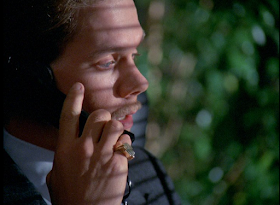 |
| Stock trader Bacon has what must be the douchiest little mustache in Hollywood film history. |
And of course he also blew his father's whole retirement savings in the same inexplicable gamble. The scene where he breaks the news to his dad is one of the few moments with any emotional heft in the film.
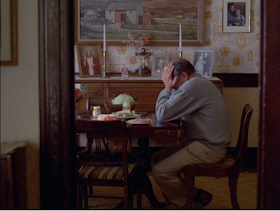 |
| "Sorry dad, I blew your entire life's savings on a single risky trade - you know, 'cuz I'm a really gifted stockbroker." |
So rather than picking himself up and trying to rebuild himself (like his stock trading partners all seemed to have been able to do), he spends a lot of time aimlessly walking the city's crowded streets and growing out his hair. . .
Until he has an epiphany in front of a second-hand store:
 |
| Cue the angelic chorus. |
It's redemption by bike, which I guess a lot of us can kinda' relate to.
 |
| And before you know it, Jack's making a living at his new dream job - mixing it up with traffic, and wearing Vails's old maroon beret. |
Because it's an '80s movie, we have to have a whole lot of dance sequences to go with the high energy pop soundtrack.
 |
| Like Flashdance, but with a bike. I think there was some requirement back then that all post-industrial loft dwellers be aspiring dancers. |
 |
| And of course all the bike messengers routinely take time out of their busy day to jam to some tunes on their boombox and start break-dancing (or at least, bike-dancing) in the middle of the street. You know, 'cuz it's the '80s. |
Most of the film was shot in San Francisco, though I understand a few bits were shot in LA and NYC -- to give the film sort of a generic un-specified urban setting. One of the few scenes that makes the location obvious is the mano a mano messenger race between Kevin Bacon's Jack Casey vs. Laurence Fishburne's shady badass "Voodoo."
 |
| Catchin' some air. If they didn't get stunt-riders for that jump, I'm going to say that's actually pretty impressive. |
There's a whole sub-plot in the film where messengers like Voodoo get caught up running drugs for "Gypsy," the local bad-guy drug dealer (who is almost never seen outside of his POS Ford sedan), and of course that doesn't work out well for any streetwise messenger who goes in for earning the fast easy money.
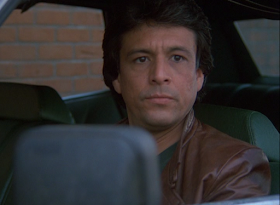 |
| Bad-guy drug dealer. |
 |
| Nooooooooo! |
 |
| Dead bike messenger. |
There's a whole cast of lovable oddball characters, mostly with clever nicknames. Like Franz -- aka "Tour de Franz," "Apache," "Voodoo," "Airborne," and "Teddy Bear." Except for Jack, who is just, well, "Jack."
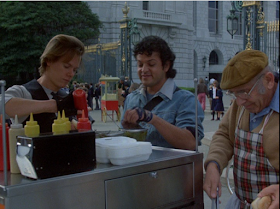 |
| Paul Rodriquez plays Hector Rodriquez (clever!) - whose dream of moving up in life is to earn enough as a bike messenger to buy a hot dog cart. Hey, a guy's got to dream. |
 |
| Comedian Louis Anderson makes an appearance as either "Tiny" or "PeeWee" (get it? 'cause he's fat) depending on whether you go by what people call him in the film, or how he's listed in the final credits. He's probably the film's least convincing bike messenger - but then, this one shot from the opening credits is the closest he's shown in proximity to a bicycle in the whole thing. |
 |
| We have culturally sensitive nicknames, like Apache and Voodoo. |
 |
| And then there's the new girl, Terri - played by Jamie Gertz. Throughout the film, Terri makes up increasingly outlandish stories about her family to cover up the fact that she doesn't have one. She also takes a job as a bike messenger, despite not having a bike and not knowing particularly well how to ride one. |
Bacon's Jack Casey has a lot of angst about his stockbroker past, and tries to keep an air of mystery about his background with the other messengers, except when trying to help them occasionally with sound financial advice. But stockbroker-to-bicycle-messenger isn't the typical "American Dream" career trajectory, so of course he frequently finds himself at odds with people's expectations.
 |
| Uptight parents . . . they just don't understand. |
 |
| Uptight stockbroker friends . . . they just don't understand. |
 |
| Uptight dancer girlfriends . . . they just don't understand. |
But when Jack learns that his friend Hector might make a big dangerous mistake to get the money for his hotdog cart, he decides to drop in on the Stock Exchange for some redemption. Before you know it, he's in there mixing it up with the hotshot stock traders again . . .
 |
| "Numbers numbers numbers BUY! Numbers numbers more numbers SELL!" |
And that's all it takes to get other stock brokers to start acting like sheep. Pretty soon all the traders are following his lead, bleating the same thing . . .
 |
| "Numbers numbers numbers. BUY! Numbers BUY! BUY!" Looks like Hector's getting his hotdog cart after all. |
While he's at it, Jack also manages to make enough to rescue his father's retirement fund, too. Oh yes - getting rich at the stock market never looked easier!
But that's not enough of a climax for the film, because Gypsy, the bad-guy drug dealer, is after Terri now, which leads to a final showdown.
 |
| Street-smart bike messengers stick together . . . |
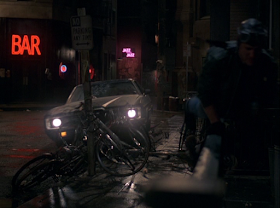 |
| . . . bad-guy drug dealer destroys their source of income. |
So now Jack leads the bad-guy on a car vs. bike chase.
 |
| Oddly enough, it's like the middle of the night and really dark when the chase scene begins . . . |
 |
| . . . then suddenly it's daylight. How long was this chase supposed to be going on? |
The whole chase scene ends about as well as it can for a guy who intentionally runs over a bunch of bicycles with his POS Ford.
 |
| Somehow Jack fools the bad guy into driving off an incomplete bridge. |
Oddly enough, after spending an entire film being encouraged that being a bike messenger is a great job for independent mavericks, in the end, all three of the main characters are found doing something else. Jack's got a "couple of real good offers" (in what, he doesn't say), and Terri's going to be a paramedic. And then they run across another old friend. . .
 |
"Should we have pizza or Chinese, or what?"
"Definitely pizza"
"I was thinking Chinese would be good."
"But I really wanted pizza."
"Wait, wait, I know the perfect place . . ." |
Quicksilver is loaded with technical goofs and continuity errors. The sudden onset of daylight in the final chase is just one. Here are some more:
 |
| In the opening sequence where Nelson Vails is racing Jack's taxi cab, we see a closeup of Vails shifting gears. He pushes the lever forward all the way, and we then see his derailleur moving up to his lowest gear. Ahhhh . . . no. |
 |
| In a scene where Jack is tailing Gypsy, Jack's outfit completely changes. One moment he's wearing a light gray top with a vest (a remnant from his 3-piece suit stockbroker days), and then the next shot he's wearing a knit sweater without the vest, then back again. Likewise, the length of Jack's hair seems to change from moment to moment throughout the film. |
 |
| Early in the film, we see Jack slam into the back of a taxi. His front wheel is visibly damaged. Harder to tell for sure, but it's likely his fork is probably bent, or the frame buckled from the impact. Moments later, he pulls up to the messenger "headquarters" with a completely undamaged bike. I will give some credit that Bacon does a pretty nice "off the back" dismount. |
 |
| The configuration of Jack's bike changes throughout the film - sometimes even at different moments in the same scene. In the "dancing" scene, the bike is noticeably equipped for trick riding - the fork is completely straight, with no rake whatsoever, and the chainring is really small - no bigger than the rear cog. There are also foot pegs on the front and rear axles. Most of the time the bike has a normal road fork and chainring. Also in the dancing scene, though the bike very noticeably has a fixed gear, some sound engineer added in the "click click click" sound effect of a spinning freewheel. In the race with Voodoo, the bike switches from one moment to the next from fixed gear to freewheeling single-speed. |
Speaking of the bikes, Raleigh USA, which was actually American Huffy with a British name placed on bikes made in Japan and Taiwan, must have put up some money and/or other support for the film. Most of the bikes used in the film (or at least the ones that can be seen with any clarity) are Raleigh USA models from about '84 - '85.
I understand that Nelson Vails (who was sponsored by Raleigh USA at one point) did offer some technical advice for the film, and provided some insight on the life of bike messengers. Also, Kevin Bacon spent about four months prior to filming training on a fixed gear track bike - some of it riding with a former messenger (who was also one of the screenwriters) in NYC - to get ready for the role. I give him credit because there are several scenes in the film where he performs some tricks or stunts on the bike, and it's clearly Bacon and not a stunt double.
When
Quicksilver came out in 1986, it opened to mostly lackluster or downright negative reviews.
Roger Ebert wrote:
"Quicksilver
is a collision between realism and gloss, between a story that demands to be told at street-level and a style that looks inspired by music videos. The movie has moments when it comes to life, when it threatens to tell a story about interesting people, and then it wanders off into inane scenes designed only to sell records."
Walter Goodman
of the
New York Times wrote:
"As long as the characters are doing stunts or whizzing impossibly through city traffic to a strong rock beat, there's something to watch. For the rest of the time, Quicksilver
is as much fun as a slow leak."
And currently, the movie rating website
Rotten Tomatoes gives the film a 13% on their Tomatometer. By comparison, Bacon's 1990 film
Tremors, which I believe was intended to be an ironically bad tongue-in-cheek sendup of 1950s B-movie monster flicks has a score of 85%. Kevin Bacon himself is reported to have called
Quicksilver one of the lowest points in his career.
I was a student at Kent State when the film came out, and I remember our university bike club hosted a screening of the film. We actually enjoyed it - or rather, we enjoyed ourselves mostly poking fun of it. But fun is fun.
Needless to say,
Quicksilver is hardly a must-see movie. But sometimes cheesy bad can still be fun. And if you're looking to satisfy that itch where nothing but an 80s pop music video masquerading as gritty drama about plucky street-smart bike messengers will do, what else are you gonna watch?




































all the memories... "Lightning!.."
ReplyDeleteI can't believe the Roger Daltry had a minor hit with that song.
DeleteIf "Quicksilver" is "Flashdance with a bike", then "Flashdance" is "Rocky" with dance moves and music. They are all cheesy but fun.
ReplyDeleteYes - they do all follow a similar formula. Roger Ebert used to have an acronym for it, CLIDVIC - or CLImb from Despair to VICtory. And yes, they are cheesy fun.
DeleteOne of my friends was a technical advisor on this film. He was sponsored by Raleigh USA for his road and track racing as well as film activities. So he often would bring them into these projects. He and Nelson Vails have known each other for a very long time, before this film.
ReplyDeleteHe also worked on American Flyers (on bike cameraman), Pacific Blue (essentially Bike cops meet Baywatch), and many commercials and select TV show episodes.
His goal was always to try to bring some realism to the cycling roles. No he couldn't stop bad scripts or poor editing, but he tried to make the bike riders look like they were real cyclists instead of Hollywood's vision of cyclists (think tennis shoe and knee sock wearing people with terry cloth sweat bands).
I thoroughly enjoyed your review of the film. It was fun. Thanks.
ReplyDeleteGreat movie I don't care what anyone says. Loved it as a 12 year old, and still love it today as a 45 year old! The irony is fixed gear has made huge waves in 2019 cuz hipsters and the movie Premium Rush. No skid stops in Quicksilver though :(
ReplyDeleteI really like this movie, along with American Flyers, Breaking Away and Premium Rush, American Flyers, being my favorite.
ReplyDeleteI really don't like it when the star of the film distances himself from the film.
For example, Kevin Costner has never since mentioned or acknowledged American Flyers. I think that is an insult to the fans of the film, not to mention his co-stars, and everyone who worked on the film.
He was a struggling actor when he took the role, but when he made it big, all of a sudden he's too good for the project and the people who worked with him on the film.
Kevin Bacon has stated that Quicksilver was the lowest point in his career.
I would disagree. I don't think bending over and being paddled in, "Animal House", is anything to be proud of, neither was his performance in, "Friday the 13th".
I would think that integrity as an actor is doing your best and standing behind your work.
On that note, I found a 1985 review of American Flyers, by Roger Ebert.
He explains the plot to criticize the film, even going as far as to list his points by number, and then proceeds to get plot completely wrong.
If you are going to make a living as a movie critic, then job one should be to get the facts of the film right, before pointing out someone else's shortcomings.
Just my opinion.